While retracing the steps of Cpl Noel B Hall of the 2nd Canadians at WWI we visited the village of Courcelette after spending a bit of time at the memorial to the Canadians on the Albert-Bapaume road. The village is small – a church and about 30 houses. 19th Battalion didn’t fight in the village however I’m fairly sure they would have passed through it or very close to it later, based on the information from the War diaries of 4th Brigade.
- Sign to the village of Courcelette
- The main road through Courcelette
The road layout has remained the same even though the fighting and shelling during WWI destroyed or badly damaged most of the buildings. The village still looks old as the houses have been rebuilt, often using the same materials and designs.
- Courcelette Church
- Courcelette War memorial in the village green
- Local Courcelette soldiers who died in the war
- Local Courcelette soldiers who died in the war
- Information board about the Battle of Courcelette
- Information board about the Battle of Courcelette
- Memorial slabs on Courcelette village green
- Memorial to the Canadian soldiers in Courcelette village
In the centre of the village is the church and a small green which has become the war memorial for those of the village who died fighting. There is also a memorial to the Canadians and an information display showing a map and description of what happened. The small, old trees around the green have hand-made large poppies strung from their branches in places. It is clearly a place of pilgrimge for many people.
After visiting Courcelette we found our way to the nearby British Cemetery. I was intrigued to discover that the memorial entrance to the Cemetery was designed by Sir Herbert Baker who also designed St George’s Cathedral in Cape Town where I grew up.
- Information board about the Somme battles
- Map of the Somme campaign
- Courcelette British Cemetary designed by Sir Herbert Baker
- Courcelette British Cemetary
- Courcelette British Cemetary
- Inscription at Courcelette British Cemetary
The Commonwealth War Graves Commission (CWGC) cemeteries are all immaculately maintenained with the graves in neat symetrical rows, like a military parade. It was very sobering reading the number of headstones inscribed with the simple words “A solder of the Great War – known only to God”. We came across the grave of a Canadian soldier who died on the same day as Noel and was the same age, though at the Somme rather than near Lens.
The descriptions of the Somme battles showed that this peninsular of farmland between Bapaume, Albert, the rivers Ancre and Somme was hotly contested, taken and retaken at various times during the 4 1/2 long weary years of war and that early graves were often pulverised in later battles which meant that many bodies were never found or were unidentified. Sometimes bodies are still uncovered during farming or building operations, when possible they are identified, they are always reburied with full military honours in one of the military cemetaries. And the farmers are always ploughing up shrapnel, spent ammunition casings, shovels, cooking utensils and personal belongings.
Next we made our way to the Thiepval Memorial as I needed to find out if they could explain a place name I had come across several times in the War Diary of the 4th Brigade but could not find on a map. The Brigadier-General had used local place names as well as nicknames for the newly dug trenches in his descriptions of events and I wanted to find Sausage Valley as it seemed to be a place where the troops were sent back to from the front line for a temporary rest.
At the Thiepval Memorial they have an information desk by the main entrance door to the Visitors Centre and this was run when we arrived by a very helpful person (she was English but lives long term in France) who looked it up in a detailed map guide book she had under the desk. She was able to give me exact co-ordinates for the valley – 1000 metres south of La Boisselle and gave us the electrifying information that there was also a Mash Valley on the other side of the village 600 metres west of La Boisselle. We had a good laugh about the British sense of humour which must have resulted in those two valleys being given such names by the armies who used them. She also photocopied a map from her book showing the positions of these valleys.
We asked the Thiepval guide about visiting actual trenches and she told us about Beaumont-Hamel nearby. So rather than look at the museum at Thiepval that afternoon we made our way into the Ancre river valley. The river flood pools in the valley inspired JRR Tolkein’s descriptions of the Dead Marshes in The Lord of the Rings as Tolkien fought in the Somme in 1916. The valley is quite wooded, though maybe 100 years ago many of the trees were destroyed in the war which would have added to the ghostly atmosphere.
Beaumont-Hamel is a rocky hilltop and valley battlefield riddled with trenches which have been preserved under grass. So many of the 1st Battalion Newfoundlander Soldiers died there on the first day of the Somme (70% of their number) it is treated as one large war grave – a sacred site. It contains 3 CWGC cemetaries.
- Entrance to Beaumont Hamel
- Entrance to Beaumont Hamel
- About Beaumont-Hamel, Newfoundlanders and the Great War
At the entrance and the top of the site the area is wooded and there are plenty of trenches, half filled in. We spotted fungi and a couple of red squirrels, so immediately thought of Ellie, who would have been delighted to see them if she had been with us.
- St John’s Road trenches at the entrace of Beaumont-Hamel
- Beautiful toadstools at Beaumont-Hamel
- Red Squirrel at Beaumont-Hamel
- Red Squirrel at Beaumont-Hamel
- Red Squirrel at Beaumont-Hamel
- Red Squirrel at Beaumont-Hamel
At the edge of the trees is the dramatic Caribou monument on a stone cairn overlooking the ridge and the valley. There is a trench at the top of the ridge, it has a boardwalk and is usable. The path leads downhill into the valley to the British frontline trench which still contained some of the metal side wall supports. Further on we saw the metal stakes used for holding the large coils of barbed wire which would have been stretched along the top of the trenches.
- The Caribou monument at Beaumont-Hamel
- Walking in the British trench at the top of the ridge
- The British trench with the Caribou monument behind it
- The British front line trench still with its metal supports
- Walking towards the Wellington Trench
- The petrified tree ‘danger tree’ near where so many died
- A large shell crater
- The Wellington Trench
In the valley beyond the Wellington Trench and close to the German frontline (which was just over the other side of the ridge leading down to Y Ravine) is the Y Ravine Cemetery.
- The Y Ravine Cemetery
- The Y Ravine Cemetery
We walked up the hill to the German front line trenches and the heavily fortified Y Ravine. These trenches were roped off as not safe to walk in as there is still plenty of ammunition embedded in the ground. There was a place to look into the Y Ravine immediately opposite the 51st Highland Division monument. Beyond this monument was the Hunter’s Cemetery, a circular memorial which used a bomb crater as a grave pit.
- 51st (Highland) Division Memorial
- 51st (Highland) Division Memorial
- Hunter’s Cemetery
- Hunter’s Cemetery
- Hunter’s Cemetery
It was a short walk to the Hawthorn Ridge Cemetery No. 2 which contained gravestones closely fitted side by side, often with double burials.
- Approaching Hawthorn Ridge Cemetery No. 2
- The grave of an H Willis in Hawthorn Ridge Cemetery No. 2
- Hawthorn Ridge Cemetery No. 2
We were back under the trees again, maple leaves floating down as we walked along Maple Walk back to the Caribou monument.
- Maple Avenue
- Maple Avenue, approaching the Caribou monument
- The Newfoundlander’s memorial at the Caribou monument
As we walked towards the museum building we saw the remains of a Gun carriage, it made me think of Noel serving a gun and the dangers posed to soldiers if they made a mistake or if ammunition was faulty. There was also a poem by John Oxenham inscribed on a plaque beside a tree inviting those who visited to think about the sacrifice of those soldiers and the responsibility future generations have to uphold peace.
- The remains of a gun carriage
- Memorial tree and poem
- The Poem by John Oxenham
Although Noel had not fought at Beaumont-Hamel, seeing preserved trenches (even though grassed over) brought the realities of the battle into focus.
After we left Beaumont-Hamel we drove down into the Ancre valley again and to Albert, past the Basilica in the centre of the town and on to the hotel. In the evening we returned to the centre of Albert for a meal and I photographed the Basilica which had been fully restored after suffering terrible damage during the war, the golden statue ‘The Leaning Virgin’ standing once more on top of the tower after being knocked sideways during the early part of the war and later knocked right off near the end of the war. There was also a statue of a Scottish Highlander near the restaurant which I couldn’t resist photographing if only for its nickname.
- Albert Basilica
- Albert Basilica
- The Scottish piper or ‘lady from hell’
- Plaque about The Scottish piper or ‘lady from hell’
It had been a long and fascinating day discovering the Somme and putting Noel’s story into context but there was more to explore the next day including Sausage Valley, to be covered in Part 3.
See also Visit to the Somme – part 1, Visit to the Somme – part 3 and Visit to the Somme – part 4
References:




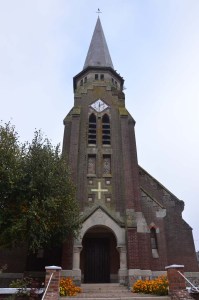






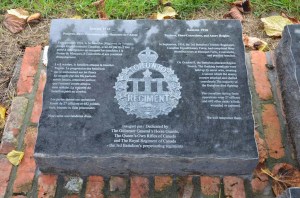

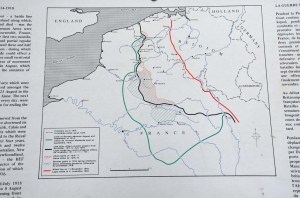


















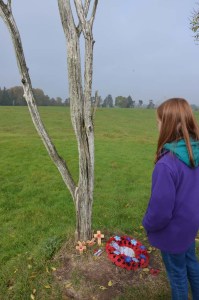












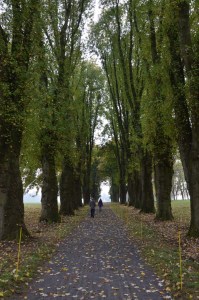

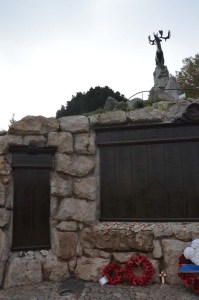


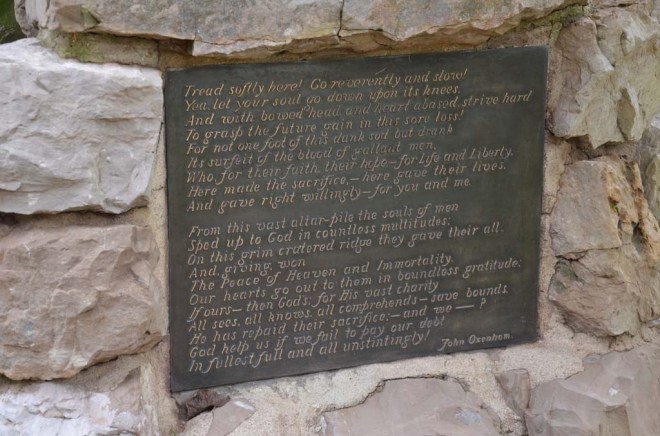




Pingback: Visit to the Somme – part 3 – AnnaCPage’s Blog
Pingback: Visit to the Somme – part 1 – AnnaCPage’s Blog
Pingback: Visit to the Somme – part 4 – AnnaCPage’s Blog
Pingback: H818 Networked Practitioner Conference – A rabbit in the headlights! – AnnaCPage’s Blog
It’s been very frustrating trying to research my WWI soldiers all the way from Australia unable to get onto the ground. Geography and having a sense of place is so important for really getting a feel for such a monumental experience. So, I really appreciate being able to see your photos. I’ve only just realized how big these craters could be and your photo captures that well.
After seeing the statue of the Scottish piper, I thought you’d appreciate this reference I found in a letter from Australian soldier Roy McLarty sent from Ypres:
Pg 63
Belgium 10th October, 1916. (Hooge Chateau)
We are stationed just outside of Y_______. The gun pits are hidden in the ruins of a once stately palace. In places, the Firing Line is but 1000 yards away, but it winds and twists in such an extraordinary way that no matter in which direction you gaze at night you are sure to see the glow of a star shell.
Pg 64
It is rumoured – and I believe it is true- that this crumbling ruin was the country residence of the late King Leopold of infamous memory. The palace is surrounded by a pretty moat, and an old fashioned drawbridge leads you to the palace entrance. A most beautiful old garden extended over – I should say – 20 acres, has run wild and frets under the scars of a thousand shell wounds. The trees are torn about terribly, but the garden itself is filled with a myriad of blossoms. Here and there pretty statues add further charm to this place. One I noticed has come under the tender care of some wag, who has dressed it in the clothes of a soldier. In peace times this lady would charm your eye, standing in graceful robes, scythe in hand, looking out at her garden, but now with a disreputable tin hat, slanted jauntily over her head, a Scotch plaid tied around her amidships, and a rusty knife in her hand, she is by no means a vision of beauty. I gather each day a bunch of roses and adorn the gun pit with them.
I wish someone had taken a photo of that.
Best wishes,
Rowena